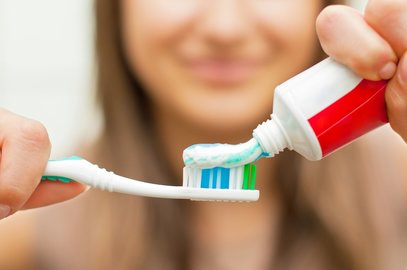HYGIENE TREATMENT

A daily oral hygiene regimen is needed to remove the dental plaque that causes tooth decay and gum disease. And good oral hygiene not only helps prevent cavities, but is necessary to battle bad breath. After all, we go to great lengths to look and smell pretty. why not treat our teeth as well as we treat our bodies?
Making an effort to focus on your dental health will not only produce a dazzling smile, but has some added benefits as well. Since oral health is linked to overall health, good oral hygiene can improve your well-being. When your oral health is neglected, bacteria multiply and wreak havoc on your mouth.
If gums become infected with periodontal disease, harmful bacteria can actually enter the bloodstream and make its way to other parts of the body. Practicing good oral hygiene can reduce your chances of developing complications or illnesses from a dental disease and could prevent the need for a costly gum treatment.
Proper brushing Techniques
1. Always use a soft bristled toothbrush
2. Use Fluoride toothpaste
3. Hold toothbrush at a 45-degree angle at the gum line, brushing in a circular motion (This sweeps plaque out of the gingival pocket)
4. Brush teeth for a minimum of two minutes at least twice a day.
5. Brush gums and tongue along with your teeth.
6. Don’t brush too hard because this can cause gingival (gum) recession.
Proper flossing technique and the reason for flossing
1. Use an arms length (18 inches) of floss. Wrap around fingers mostly to one side.
2. Floss each tooth forming a “C” shape with the floss each time.
3. A new area of floss should be introduced into each gingival pocket.
4. Don’t forget to floss behind your last molar.
5. Flossing removes plaque from behind your teeth that brushing misses.
6. Flossing helps prevent periodontal disease by removing plaque.
Mouthwash
Antibacterial mouthwash can also remove the bacteria that cause dental plaque. This helps prevent gingivitis, the first stage of gum disease. Like fluoride toothpastes, fluoride rinses help strengthen teeth and prevent tooth decay. However, mouthwash with alcohol is not recommended.
Types of oral disease and ways they can easily be prevented:
Dental Caries (cavities)
• Brushing and flossing
• Fluoride rinse from your dentist if he or she recommends it for you
• Reduce your carbohydrate intake along with simple sugars
• Some fruits are more acidic than others (oranges and tomatoes are some)
• Visiting the dentist for cleanings every 6 months.
Periodontal Disease
When you do not brush or floss regularly, dental plaque (a sticky film filled with bacteria), forms on your teeth. Dental plaque can infect your gums and the sulcus, the v-shaped crevice just below the gum line.
At this stage, the infection is called gingivitis. If it progresses, it is called periodontitis. Both are also knwon as gum disease.
The cause of periodontal disease is primarily dental plaque that turns into calculus or tartar within 26 hours if not removed. Dental plaque can be prevented by practicing good oral hygiene. That means brushing and flossing regularly; visiting the dentist for regular checkups and dental cleaning; and maintaining a well-balanced diet.
Making an effort to focus on your dental health will not only produce a dazzling smile, but has some added benefits as well. Since oral health is linked to overall health, good oral hygiene can improve your well-being. When your oral health is neglected, bacteria multiply and wreak havoc on your mouth.
If gums become infected with periodontal disease, harmful bacteria can actually enter the bloodstream and make its way to other parts of the body. Practicing good oral hygiene can reduce your chances of developing complications or illnesses from a dental disease and could prevent the need for a costly gum treatment.
Proper brushing Techniques
1. Always use a soft bristled toothbrush
2. Use Fluoride toothpaste
3. Hold toothbrush at a 45-degree angle at the gum line, brushing in a circular motion (This sweeps plaque out of the gingival pocket)
4. Brush teeth for a minimum of two minutes at least twice a day.
5. Brush gums and tongue along with your teeth.
6. Don’t brush too hard because this can cause gingival (gum) recession.
Proper flossing technique and the reason for flossing
1. Use an arms length (18 inches) of floss. Wrap around fingers mostly to one side.
2. Floss each tooth forming a “C” shape with the floss each time.
3. A new area of floss should be introduced into each gingival pocket.
4. Don’t forget to floss behind your last molar.
5. Flossing removes plaque from behind your teeth that brushing misses.
6. Flossing helps prevent periodontal disease by removing plaque.
Mouthwash
Antibacterial mouthwash can also remove the bacteria that cause dental plaque. This helps prevent gingivitis, the first stage of gum disease. Like fluoride toothpastes, fluoride rinses help strengthen teeth and prevent tooth decay. However, mouthwash with alcohol is not recommended.
Types of oral disease and ways they can easily be prevented:
Dental Caries (cavities)
• Brushing and flossing
• Fluoride rinse from your dentist if he or she recommends it for you
• Reduce your carbohydrate intake along with simple sugars
• Some fruits are more acidic than others (oranges and tomatoes are some)
• Visiting the dentist for cleanings every 6 months.
Periodontal Disease
When you do not brush or floss regularly, dental plaque (a sticky film filled with bacteria), forms on your teeth. Dental plaque can infect your gums and the sulcus, the v-shaped crevice just below the gum line.
At this stage, the infection is called gingivitis. If it progresses, it is called periodontitis. Both are also knwon as gum disease.
The cause of periodontal disease is primarily dental plaque that turns into calculus or tartar within 26 hours if not removed. Dental plaque can be prevented by practicing good oral hygiene. That means brushing and flossing regularly; visiting the dentist for regular checkups and dental cleaning; and maintaining a well-balanced diet.

Other factors that can increase the risk of periodontal disease include cigarette smoking, genetics, pregnancy and medications (steroids, cancer therapy drugs, oral contraceptive)
a) Gingivitis is the first stage of periodontal disease and is completely curable.
1. Bleeding gingival tissue while brushing teeth
2. Red puffy gingival tissue
3. May be sensitive to touch
4. Bad breath (Halitosis)
b) Mild Periodontal disease (pocket dept <4-5mm)
1. Recession of gingival tissue
2. May be sensitive to hot and cold liquids or foods
3. Root exposed due to gingival recession
4. Slight bone loss
c) Moderate Periodontal Disease (pocket depth 5-6mm)
1. Further recession of gingival tissue
2. Usually large amounts of plaque and calculus build up
3. Dental caries may form on root surface
4. Bone loss and periodontal ligament detachment
d) Advanced Periodontal Disease (pocket depth >7-9mm)
1. Teeth could be loose or spaces develop between teeth
2. Puss maybe within gingival pocket
3. Major bone loss along with damaged periodontal ligaments.
Treatments:
• Gingivitis is reversible with professional care and good home dental care.
• Periodontitis require more substantial gum disease treatment. Non-surgical method of treating is scaling and root planing procedure (SRP). SRP is a careful cleaning of root surface to remove dental plaque and calculus, and then smoothes the tooth root to remove bacterial toxins.
• Surgical procedure for periodontal disease include pocket reduction procedures, crown lengthening and soft tissue g
a) Gingivitis is the first stage of periodontal disease and is completely curable.
1. Bleeding gingival tissue while brushing teeth
2. Red puffy gingival tissue
3. May be sensitive to touch
4. Bad breath (Halitosis)
b) Mild Periodontal disease (pocket dept <4-5mm)
1. Recession of gingival tissue
2. May be sensitive to hot and cold liquids or foods
3. Root exposed due to gingival recession
4. Slight bone loss
c) Moderate Periodontal Disease (pocket depth 5-6mm)
1. Further recession of gingival tissue
2. Usually large amounts of plaque and calculus build up
3. Dental caries may form on root surface
4. Bone loss and periodontal ligament detachment
d) Advanced Periodontal Disease (pocket depth >7-9mm)
1. Teeth could be loose or spaces develop between teeth
2. Puss maybe within gingival pocket
3. Major bone loss along with damaged periodontal ligaments.
Treatments:
• Gingivitis is reversible with professional care and good home dental care.
• Periodontitis require more substantial gum disease treatment. Non-surgical method of treating is scaling and root planing procedure (SRP). SRP is a careful cleaning of root surface to remove dental plaque and calculus, and then smoothes the tooth root to remove bacterial toxins.
• Surgical procedure for periodontal disease include pocket reduction procedures, crown lengthening and soft tissue g
